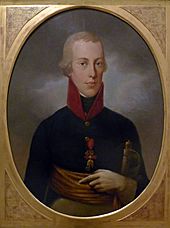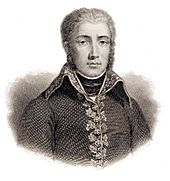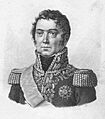Battle of Hohenlinden facts for kids
Quick facts for kids Battle of Hohenlinden |
|||||||
|---|---|---|---|---|---|---|---|
| Part of the War of the Second Coalition | |||||||
 Moreau at Hohenlinden (Galerie des Batailles, Palace of Versailles) |
|||||||
|
|||||||
| Belligerents | |||||||
| Commanders and leaders | |||||||
| Strength | |||||||
| Total: 53,595
41,990 infantry 11,805 cavalry 99 guns |
Total: 60,261
46,130 infantry 14,131 cavalry 214 guns |
||||||
| Casualties and losses | |||||||
| 2,500-3,000 dead or wounded 1 gun |
Total: 13,550-15,500
4,600-5,500 dead or wounded 8,950-10,000 captured 76 guns |
||||||
The Battle of Hohenlinden was a major fight during the French Revolutionary Wars. It happened on December 3, 1800. A French army, led by General Jean Victor Marie Moreau, won a huge victory. They defeated an army from Austria and Bavaria, which was led by the 18-year-old Archduke John of Austria.
This loss forced the Austrian and Bavarian forces to retreat. They had to ask for a ceasefire, which basically ended the War of the Second Coalition. Hohenlinden is a town about 33 kilometers (20 miles) east of Munich in modern-day Germany.
General Moreau's army had about 56,000 soldiers. They faced around 64,000 Austrian and Bavarian troops. The Austrians thought they were chasing a defeated enemy. They marched through thick forests in four separate groups. Moreau set a trap for them. He attacked the Austrians as they came out of the Ebersberg forest. At the same time, a French division under Antoine Richepanse made a surprise attack on the Austrian left side. Moreau's generals worked together very well. They managed to surround and crush the largest Austrian group.
This big win, along with a French victory at the Battle of Marengo earlier in 1800, ended the War of the Second Coalition. In February 1801, the Austrians signed the Treaty of Lunéville. This agreement gave France control of lands up to the Rhine River. It also recognized French-controlled republics in Italy and the Netherlands. Later, the Treaty of Amiens between France and Britain brought the longest period of peace during the Napoleonic Wars.
Contents
Background to the Battle
From April to July 1800, General Moreau's French army pushed the Austrian army back. They won battles at Stockach, Messkirch, and Höchstädt. On July 15, both sides agreed to a temporary stop in fighting, called an armistice.
The Austrian Emperor, Francis II, realized his general, Pál Kray, wasn't doing a good job. So, he removed him from command. The emperor then offered the job to other leaders, but they all said no. Finally, he appointed his 18-year-old brother, Archduke John.
Since Archduke John was very young and had no experience, the emperor assigned Franz von Lauer to help him. Lauer was promoted and told to guide John. To make things even more confusing, an aggressive officer named Franz von Weyrother became John's chief of staff.
The armistice ended on November 12. By then, Weyrother had convinced Archduke John and Lauer to attack. Weyrother's plan was to crush the French army's left side near Landshut. Then, they would move south to cut off Moreau's supply lines near Munich.
After a few days, it was clear the Austrian army was too slow for this big plan. So, Lauer convinced the archduke to change it to a direct attack on Munich. Even with this change, the sudden Austrian advance surprised the French.
In the Battle of Ampfing on December 1, the Austrians pushed back part of the French army. The French lost about 1,700 soldiers but caused 3,000 Austrian casualties. The next day, the Austrians found that the French had left the town of Haag in Oberbayern. This made Archduke John and Weyrother very happy. They ignored Lauer's warnings and chased the French, thinking they were running away.
However, Moreau decided to stop and fight. He set up his army in open ground near Hohenlinden. To reach him, the Austrian and Bavarian forces had to march directly west through thick forests.
Battle Plans
Moreau's main defense line had four divisions facing east. From north to south, these were led by General Claude Legrand, General Louis Bastoul, General Michel Ney, and General Emmanuel Grouchy. Moreau also kept 1,700 heavy cavalry soldiers under General Jean-Joseph Ange d'Hautpoul as a reserve.
Further south, near Ebersberg, were two more divisions. These were led by General Antoine Richepanse and General Charles Decaen. Moreau planned for Richepanse to march northeast. His goal was to attack the Austrian left, or southern, side by surprise. Moreau's main line would fight in the open. They would counterattack the Austrians as they came out of the woods. Decaen's division would help Richepanse.
The Austrian plan, made by Weyrother, involved four groups marching west. From north to south, they were led by General Michael von Kienmayer, General Louis-Willibrord-Antoine Baillet de Latour, General Johann Kollowrat, and General Johann Sigismund Riesch. The three southern groups marched near the main road from Haag to Hohenlinden. Kienmayer's group followed the Isen River valley.
Archduke John rode with Kollowrat's group, which used the main highway. Latour used paths north of the highway, while Riesch used paths to the south. Because of the thick forests, bad roads, and poor planning, the Austrian groups were not close enough to help each other. Their commanders wrongly believed the French were running away. They rushed to catch them before they could escape.
The Battle Unfolds
All Austrian groups started marching at dawn. Kollowrat's group, on the main highway, moved quickly despite heavy snow. At 7:00 AM, their lead soldiers met the French 108th Line Infantry. These French soldiers were part of Grouchy's division. They fought deep in the forest and held their ground at first. But the Austrians attacked their side and pushed them back. Kollowrat sent in more Bavarian soldiers to keep the attack going.
As the Austrians came out of the trees, Grouchy led a strong counterattack with infantry and cavalry. Kollowrat's troops were pushed back. French cavalry broke through their lines and captured an artillery battery. Both Austrian General Spannochi and the French Colonel Marcognet were captured. Kollowrat had lost five cannons. He decided to stop his attack until Latour and Riesch could join him on his sides. He also sent two groups of soldiers back to find Riesch's group.
Attacks on the French Sides
To the north, Kienmayer pushed French outposts from Isen. These French soldiers then fell back to Grenier's main defense line. Prince Karl of Schwarzenberg, leading Kienmayer's left division, moved southwest. He attacked the French divisions of Bastoul and Ney. The Austrians captured the town of Forstern. But Moreau sent in his reserve cavalry to help push them out. A back-and-forth fight happened over several small towns.
Latour's group, moving on muddy forest paths in snow and sleet, was very late. By 10:00 AM, his group was still far behind Kollowrat's. He could hear fighting from Kienmayer's and Kollowrat's battles. Even more worrying were sounds of battle from the south. Latour made a strange choice. He split his divisions into small groups. He sent some north to find Kienmayer and some south to find Kollowrat. This left him with only a few battalions and cavalry units.
Richepanse's Surprise Attack
Like Latour, Riesch's troops struggled with bad roads and snow. They were far behind Kollowrat, reaching Albaching only at 9:30 AM. Because of this, Richepanse's French division marched right in front of Riesch. Near the village of St. Christoph, two Austrian groups, sent by Kollowrat, ran into Richepanse's marching column. This cut his division in half.
Richepanse, determined to continue, left his rear group to fight. He pushed north with his lead group. With his soldiers in front, Richepanse took the village of Maitenbeth. He then moved onto the main highway. There, he met some Austrian cavalry. Richepanse left his two lead units to face the Austrian cavalry charges. He then turned his main group west onto the highway. He knew this path would take him directly behind Kollowrat's army.
Hearing gunfire to the east, Weyrother gathered three Bavarian groups from Kollowrat's column. He sent them to investigate. These units moved southeast and got caught in the fight with the French. Two more Bavarian groups appeared and blocked Richepanse's path. After a short fight, Richepanse's men defeated them, and Weyrother was wounded.
Riesch's scouts told him that two French divisions were in the area. Instead of pushing into the fight, he decided to wait for his scattered soldiers to arrive at Albaching. He then made the same mistake as Latour. He split his two strong divisions into five small groups. He sent each group forward on a different forest path. Riesch kept three battalions and most of his cavalry as a reserve.
The Turning Point
At 11:00 AM, Decaen arrived to help the French near the southern edge of the battlefield. The situation was very confusing, with units running into each other in heavy snowfall. The new French soldiers finally broke through the Austrian lines. The French pushed north to the highway, where the 8th Line was still fighting Austrian cavalry. Decaen's men turned east to fight Riesch. Decaen's soldiers defeated Riesch's small groups one by one. They pushed them back to the hills of Albaching. The Austrians managed to hold their hilltop position. They captured 500 French soldiers but lost 900 of their own.
Moreau sensed victory and ordered his divisions to attack around noon. Ney, not bothered by Latour's weak attacks, swung to his right. He began to heavily attack Kollowrat's troops. Ney pushed his attack, taking over their positions. He captured 1,000 soldiers and ten cannons. Grouchy also attacked again. Kollowrat's group was surrounded on three sides by Ney, Grouchy, and Richepanse. It finally broke apart in a messy retreat. Archduke John escaped on a fast horse. But many of his men were not so lucky. Thousands of Austrians and Bavarians surrendered. Also, over 60 cannons fell into French hands.
Latour learned about the defeat of the central column when its fleeing soldiers flooded the nearby woods. He left his position and retreated to Isen, leaving Kienmayer to fight alone. When Kienmayer heard about Kollowrat's destruction, he ordered his division commanders to fall back. After a short fight, Archduke Ferdinand pulled back. The French reported fewer than 300 casualties. They captured 500 prisoners and three guns. Thanks to Schwarzenberg's good leadership, his division escaped a very difficult situation. He managed to get his soldiers to safety that evening without losing a single cannon.
Aftermath of the Battle
The Austrians reported heavy losses. They had 798 killed, 3,687 wounded, and 7,195 prisoners. They also lost 50 cannons and 85 artillery supply wagons. Bavarian losses were 24 killed and 90 wounded. But they also lost 1,754 prisoners, 26 cannons, and 36 supply wagons. In total, this means about 4,600 killed and wounded, plus 8,950 soldiers and 76 guns captured. The French reported fewer losses, about 1,839 soldiers, one cannon, and two supply wagons. However, some French units didn't report their numbers. So, Moreau's army probably lost at least 3,000 men.
After the disaster, the Austrian leaders blamed Lauer. He was quickly removed from his position. Archduke John blamed Riesch for being slow. He also thought Latour and Kienmayer were at fault. Weyrother was not blamed. In fact, his plan for the Battle of Austerlitz in 1805 also led to a big defeat. A Bavarian general blamed Austrian lack of knowledge and poor skills. Except for Schwarzenberg, the Austrian commanders didn't show much initiative. Meanwhile, Moreau's division commanders did very well, especially Richepanse.
Archduke John ordered his discouraged army to retreat. Moreau chased them slowly until December 8. Then, in 15 days, his forces advanced 300 kilometers (186 miles). They captured 20,000 Austrians. The French pushed back Riesch at Rosenheim on December 9. At Salzburg on December 14, the archduke held off the French in a successful rear-guard action. However, in several battles over the next week, the Austrian army lost its organization. Richepanse was very brave and skilled during this chase.
On December 17, Archduke Charles took over command from his brother John. By then, the Austrian army was almost completely broken. With French forces only 80 kilometers (50 miles) from Vienna, Charles asked for a ceasefire. Moreau agreed on December 25. The resulting Treaty of Lunéville was signed in February 1801. This treaty was very good for France. The clear French victory at Hohenlinden made Moreau a possible rival to Napoleon Bonaparte.
Legacy of Hohenlinden
The battle is the topic of a poem called Hohenlinden by Thomas Campbell (1777–1844). The first part of the poem says:
- On Linden, when the sun was low,
- All bloodless lay the untrodden snow;
- And dark as winter was the flow
- Of Iser, rolling rapidly.
—Thomas Campbell.
Two cities in the United States, Linden, Alabama, and Linden, Tennessee, are named after this battle. Linden, Alabama, was created to be the county seat of Marengo County, Alabama. The first European settlers in that county were French people who supported Napoleon. Many of the towns they built were named after Napoleon's victories.
Images for kids















